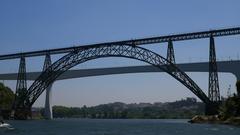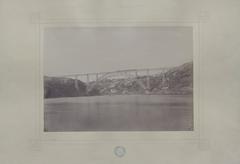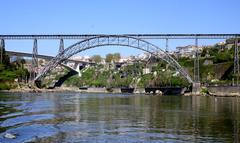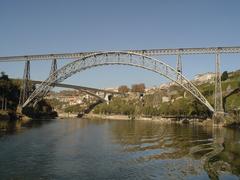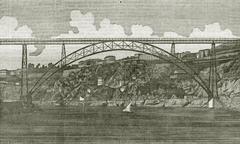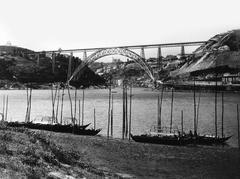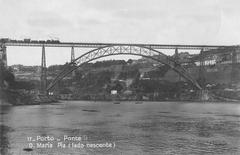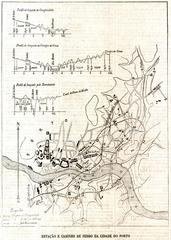
Maria Pia Bridge in Porto: Visiting Hours, Tickets & Historical Significance
Date: 14/06/2025
Introduction
The Maria Pia Bridge (Ponte Maria Pia) is one of Porto’s most celebrated engineering marvels and a symbol of 19th-century innovation. Designed by Gustave Eiffel and Théophile Seyrig, this iconic iron railway bridge dramatically transformed transportation across the Douro River, connecting Porto to Vila Nova de Gaia and facilitating Portugal’s industrial modernization. Although retired from railway service and closed to pedestrian access, the bridge remains a National Monument and an enduring highlight of Porto’s historic skyline. This comprehensive guide covers the bridge’s history and legacy, practical visitor information, top viewing spots, and tips for exploring Porto’s industrial heritage (Atlas Obscura; Structurae; ASCE).
Table of Contents
- Historical Background
- Visiting the Maria Pia Bridge
- Travel Tips and Nearby Attractions
- Frequently Asked Questions (FAQ)
- Visuals and Media
- Conclusion
- Sources and Further Reading
Historical Background
Conception and Purpose
Commissioned in the late 1870s, the Maria Pia Bridge was conceived to address a critical transport need: a permanent and reliable rail connection between Porto and Lisbon. Previously, trains and goods crossed the Douro River only by ferry, which was unreliable and unsafe. The bridge was named after Queen Maria Pia of Savoy, reflecting its royal patronage and national significance (Atlas Obscura).
Design and Engineering Innovation
Gustave Eiffel, in collaboration with engineer Théophile Seyrig, won the design competition with a bold and cost-effective proposal: a single-hinged wrought iron crescent arch. Upon its completion in 1877, the Maria Pia Bridge’s main span of 160 meters (525 feet) set a world record for the longest iron arch, and its total length of 352 meters (1,155 feet) soared 60 meters (197 feet) above the river (Structurae). The latticework of wrought iron minimized material use while maximizing strength, setting new standards in bridge engineering.
Construction and Milestones
Built between January 1876 and November 1877, the bridge’s construction was a technical feat. Over 1,600 tons of wrought iron were assembled using innovative cable-stayed supports and floating scaffolding. The bridge was inaugurated in the presence of the Portuguese royal family, with its successful completion marking a turning point in European bridge construction (Wanderlog).
Historical Significance and Preservation
As the first permanent railway crossing over the Douro, the Maria Pia Bridge revolutionized mobility, trade, and economic integration in northern Portugal. It played a vital role in the Linha do Norte rail network, connecting Porto with Lisbon and the wider Iberian Peninsula (CP - Comboios de Portugal). Its wrought iron design influenced countless later structures, including the Eiffel Tower and Porto’s own Dom Luís I Bridge.
The bridge was retired from rail service in 1991, superseded by the São João Bridge, but remains preserved as a National Monument since 1982. Conservation efforts focus on maintaining its structural integrity and honoring its role in Porto’s industrial heritage (Structurae).
Recognition and Legacy
The Maria Pia Bridge is internationally recognized as a milestone of civil engineering. In 1990, it was declared an International Historic Civil Engineering Landmark by the American Society of Civil Engineers (ASCE). Its slender arch and elegant silhouette have inspired artists and photographers for generations, symbolizing Porto’s spirit of innovation and resilience (Porto.pt; PortoBay).
Visiting the Maria Pia Bridge
Location and Accessibility
The Maria Pia Bridge spans the Douro River to the east of Porto’s historic center, linking the Campanhã district with Vila Nova de Gaia. While the bridge itself is closed to public access for safety and preservation, it can be admired from various public vantage points along the riverbanks and from other bridges, particularly the Dom Luís I and Infante D. Henrique bridges (Portoalities).
Most viewpoints are accessible by foot, public transit, or car. The nearby Campanhã train and metro station serves as the closest major transport hub.
Visiting Hours and Tickets
There are no set visiting hours or tickets required to view the Maria Pia Bridge, as it is not open to pedestrians or vehicles. The surrounding riverbank promenades and viewpoints are public spaces accessible year-round, day or night.
Guided Tours and Best Viewing Spots
While direct access onto the bridge is not permitted, several Porto walking and river cruises include stops or commentary about the Maria Pia Bridge. The popular “Six Bridges Cruise” on the Douro offers a spectacular view from below (Portoalities). For the best photos:
- Ribeira and Gaia riverfronts: Excellent perspectives, especially during golden hour.
- Dom Luís I Bridge: Offers panoramic views of the Maria Pia Bridge and the Douro River.
- Campanhã area: Good vantage points near the former railway line and bridge abutments.
Travel Tips and Nearby Attractions
- Combine your visit with a Douro River cruise for unique bridge views.
- Explore the Dom Luís I Bridge for walkable decks and sweeping cityscapes.
- Stroll through the Ribeira District, a UNESCO World Heritage zone with lively cafes and historic architecture.
- Tour the Port Wine Cellars in Vila Nova de Gaia, just across the river.
Photography Tip: Early morning and sunset provide the best natural lighting for capturing the bridge’s lattice ironwork.
Frequently Asked Questions (FAQ)
Can I walk or drive across the Maria Pia Bridge?
No. The bridge is closed to all traffic for safety and preservation.
Are there entrance fees or tickets to see the bridge?
No. Viewing the bridge from public areas is free. Some guided tours may charge a fee.
What are the best ways to view the bridge?
From the riverbanks, Dom Luís I Bridge, or a Douro River cruise.
Is the bridge accessible for people with disabilities?
While the bridge itself is not accessible, many riverfront viewpoints and nearby attractions are.
Are guided tours available?
Yes. Many city walking and boat tours feature the Maria Pia Bridge in their itineraries.
Visuals and Media
Recommended images:
- Maria Pia Bridge at sunset (“Maria Pia Bridge Porto view at sunset”)
- Historical construction photo (“Maria Pia Bridge under construction in 1877”)
- View from Dom Luís I Bridge (“View of Maria Pia Bridge from Dom Luís I Bridge”)
For virtual tours and high-resolution images, visit official Porto tourism sites and river cruise operators.
Conclusion
The Maria Pia Bridge stands as a testament to Porto’s industrial heritage and a global milestone in engineering. Its innovative design by Gustave Eiffel and Théophile Seyrig, its pivotal role in Portugal’s railway history, and its enduring silhouette over the Douro make it an essential stop for history buffs and architecture enthusiasts. While direct access is not possible, the bridge’s legacy is best enjoyed from the scenic riverbanks, nearby bridges, or a Douro cruise. Enhance your Porto experience by exploring the city’s other historic sites and using resources like the Audiala app for up-to-date travel tips and guided tours.
Sources and Further Reading
- Maria Pia Bridge – Atlas Obscura
- Maria Pia Bridge – Structurae
- Maria Pia Bridge – ASCE Historic Landmarks
- History of the Bridges of Porto – PortoBay
- Discover Porto Bridges – Portoalities

